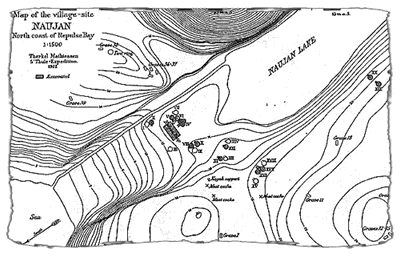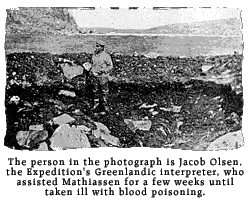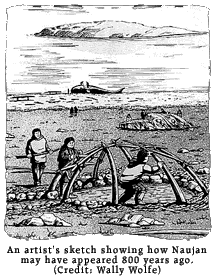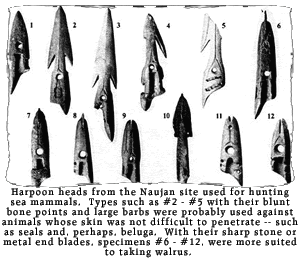|
Northern Vignettes
Arctic Harpoons
Beechey Island
Crystal II
Deline/Fort Franklin
Fort Hope
Fox Moth
Kellet's Storehouse
Naujan
Old Fort Providence
Old Fort Reliance
Stone Church
Thule Village
Yellowknife
Fort Journal
|
Mathiassen's map of the Naujan Site. Sod house ruins, graves, tent rings, a refuse heap, meat caches, and kayak stands lie across the ancient beach. The archaeological site known as Naujan (called Nauyat by local people) is one of the most important of its time period. Here in 1922 Therkel Mathiassen, a member of the Danish Fifth Thule Expedition, conducted the first scientific archaeological investigations in the Canadian Arctic. He excavated twelve of the twenty house ruins and defined the culture of the people who had lived in them. Located near the community of Repulse Bay on the northwestern margin of Hudson Bay, Naujan nestles on a grassy sward amongst rocky hills. Above the site is a lake from whose west bank rises a steep cliff. Gulls nest here, and Naujan means "the gulls."
The ancient occupants of these shelters are known as the Thule (pronounced Too-lee) people. Ancestors of the modern Inuit, they had migrated eastward across the Canadian Arctic from Alaska about 1000 years ago. They settled at Naujan around A.D. 1200, and were hunters of the great bowhead whales.
The Naujan people were well equipped with dog sleds, and kayaks for transportation. Weapons -- harpoons, lances, bows and arrows -- were used to hunt mammals on sea ice and open water. Household utensils -- drills, knives, toggles, needles -- were made of stone, bone, ivory, and antler. Carved pendants and toys also figure largely in the Naujan Thule assemblage. Several hundred years after the Thule people
settled in the Canadian Arctic, a cooling climate caused a change
in sea ice conditions and the disappearance of the great whales
from the area. People came to depend upon caribou, fish, and seal
hunted from the winter ice. The small All archaeological sites in the Northwest Territories are protected from any disturbance including the unauthorized removal of artifacts by the Northwest Territories Archaeological Sites Regulations.. Removing artifacts from sites or altering structures destroys unique and valuable information from the past. Credits: (2) Wally Wolfe; (1, 3-5) Mathiassen, Therkel. (1927) Archaeology of the Central Eskimos, Parts I and II. Report of the Fifth Thule Expedition 1921-1924. Copenhagen: Gyldendalske Boghandel, Nordisk Forlag |

 The site consists of sod house ruins, meat caches, kayak stands,
graves, tent rings, and a huge refuse heap which almost grew to
dwarf the houses of the people contributing to its growth. When
these houses were occupied, about 800 years ago, they were near
the sea on a beach. Since then, the land has risen, and today the
houses are over twelve metres above the sea's level and one hundred
metres from its edge.
The site consists of sod house ruins, meat caches, kayak stands,
graves, tent rings, and a huge refuse heap which almost grew to
dwarf the houses of the people contributing to its growth. When
these houses were occupied, about 800 years ago, they were near
the sea on a beach. Since then, the land has risen, and today the
houses are over twelve metres above the sea's level and one hundred
metres from its edge.  The
houses they constructed were substantial structures -- round or
oval, semi-subterranean with walls and roof supported by large whale
bones and insulated with sod. At the rear of the house was a sleeping
platform, raised above floor level to capture the rising heat. Often,
they were covered with flat stones and whale shoulder blades over
which had been laid baleen or heather for comfort. The floors were
usually paved with flat stones. Light and heat came from burning
sea mammal oil in a shallow stone lamp.
The
houses they constructed were substantial structures -- round or
oval, semi-subterranean with walls and roof supported by large whale
bones and insulated with sod. At the rear of the house was a sleeping
platform, raised above floor level to capture the rising heat. Often,
they were covered with flat stones and whale shoulder blades over
which had been laid baleen or heather for comfort. The floors were
usually paved with flat stones. Light and heat came from burning
sea mammal oil in a shallow stone lamp.  permanent villages on the coast such as Naujan were abandoned in
favour of larger, temporary snow-house villages on the sea ice.
Amongst the descendants of the Thule are the Aivilingmiut of Repulse
Bay.
permanent villages on the coast such as Naujan were abandoned in
favour of larger, temporary snow-house villages on the sea ice.
Amongst the descendants of the Thule are the Aivilingmiut of Repulse
Bay.